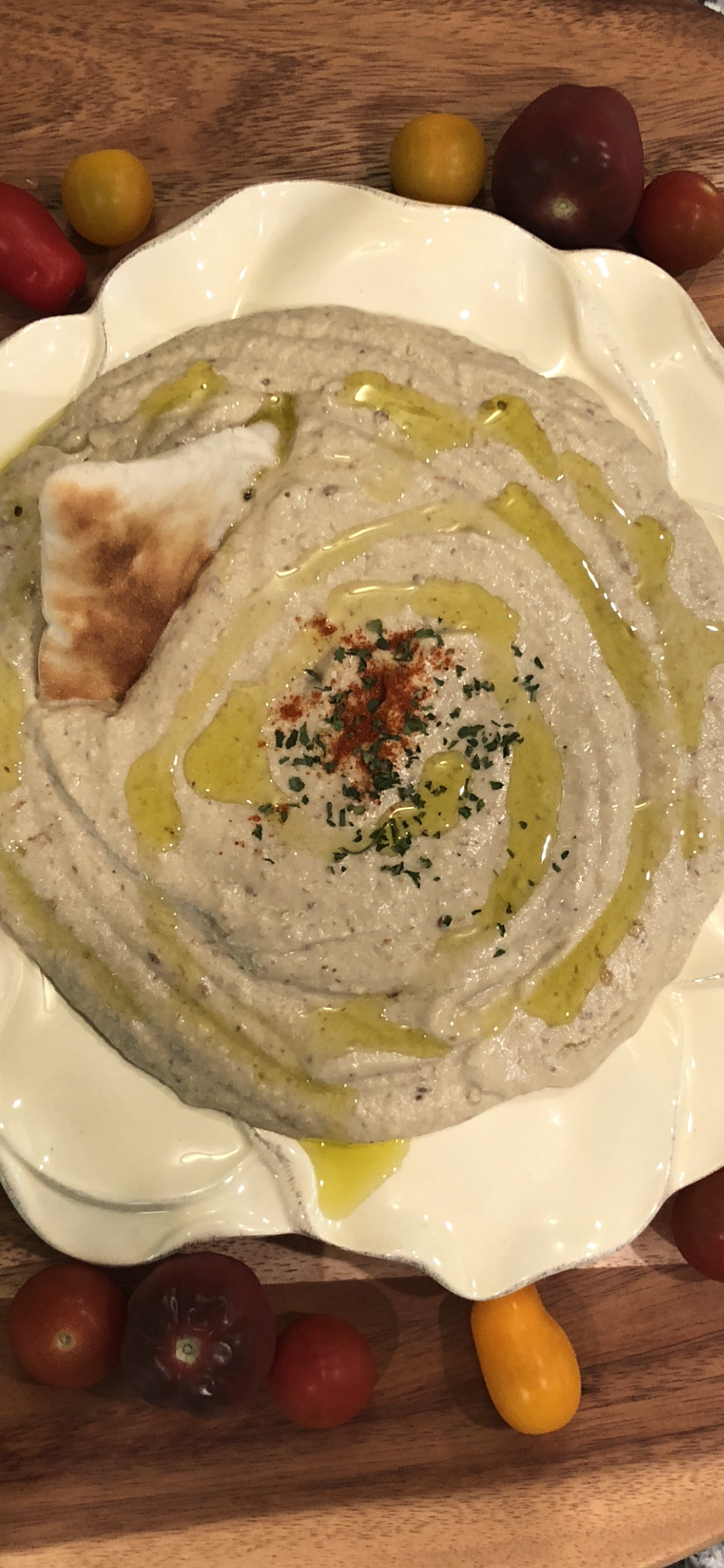And My Less Glamorous Beginnings
The first time I made baba ganoush, no one would have said they felt pampered. Instead, with the sparse amount it made, you would’ve thought I was trying to starve my guests. What can I say – I was just a kid trying to do good! I proudly collected my ingredients – eggplant, spices, lemon juice, and olive oil – and assembled them together. Was it delicious? Yes! But there was one problem – no one got more than a tablespoon! Instead of using regular-sized eggplants, I used two skinny ones. It was really only enough for one skinny kid…me. So if you really want to “pamper” your family, be sure to find the biggest, juiciest eggplants you can get for the best results! Haha 🙂
Variations Around the World
Today, this eggplant dish is still as tasty, silky, and satisfying. In fact, in some cultures it is the first dish to be presented at mealtime. Depending on which culture’s recipe you use, you will end up with several variations in the end. In Greek culture, the eggplant dish is accented with the taste of either mint or olives. In India, it is common to see curry added to the dish to give it a bit of a kick. While the Middle Eastern cultures lay claim to inventing the dish, it is also popular in parts of South America, where jalapenos and other peppers are generally added to give it some serious spice. It’s up to you to decide which spices you want to use to flavor your baba ganouj. Perhaps you want to try them all, and there’s certainly nothing wrong with that!
Here’s a tip: If you want an even more original flavor, you can add compatible ingredients to the dish. This, for starters, makes more of it, which is a good trick if you’re making an appetizer for a party or a get-together. Adding roasted tomato gives it a richer taste, and you can also add in red peppers to give the dish a bit of a sweeter taste. Not to mention, both types of tomato give the appetizer a nice festive red color, which makes it an ideal choice for serving at a party around the holidays.
A Good Choice for the Non-Meat Eaters
When you take the first bite of this dish, it is so flavorful and filling that you’d never guess it didn’t have meat. But the good news is that it’s suitable for both your vegan and vegetarian friends! Not an ounce of meat is traditionally added to this appetizer, which means that it is in turn healthier and lower in calories. This is also a key consideration for your friends and family members who may have allergies to common products and items, such as shellfish and dairy products. While it admittedly has not kept the peace in the Middle East over the years, baba ganouj is sure to bring everyone together as dish that is both healthy, suitable for a variety of dietary needs, and downright delicious. Furthermore, the dish originated in cultures that have high numbers of vegetarians today. This adds to its authenticity even more!
Follow the Leader
When you sit down to the table, this dish is one of the first, if not the first, to go out. Therefore, you’re in full control of presentation. To make the appetizer truly healthy, I like to serve it with hand-cut veggies, such as carrot sticks, slices of cucumber, or sliced celery. This is a much healthier option than putting out crackers with high-calorie dips like ranch dressing, which can pack in more fat and calories than you need before the meal even starts! And by the time the last holiday party rolls around, if not even by the first, everyone complains how they need to “stop eating like this” and return to their healthy eating habits. Rest assured, you will be helping them get one step closer to their goal!
Of course, you can honor tradition and serve baba ganouj in its customary form. It is traditionally served with either rice or pita. Either type of food makes a great base for baba ganouj, which is even flavorful enough that it could be eaten on its own. If you want to dress it up for the party, you can also spread some on a baguette and eat it that way. If you want to combine cultures and traditions, try serving it on a baguette or cracker with a topping of salsa. This is an especially popular combination in the summertime, when you can take full advantage of ripe tomatoes and basil to make an even more delicious appetizer.
Technique is Everything
Of course, as with any dish that you make, it may take some practice to make this one just right. First, you’ll want to start off with one or more juicy, thick eggplants. Don’t make the same mistake I made.. Haha! Find the thickest and juiciest eggplant.
A secret as you’re going through this phase: if you cover the eggplant with a towel, you’ll remove some of the excess moisture, which can make the end product too watery, and you will also get rid of some of the bitter taste that your guests might not enjoy. I either roast or saute the eggplant, which gives it a bit of a richer taste. Roasting the eggplant is ideal for making the dish quickly, as it takes just a few minutes to complete. When it’s done, mash the eggplant with a fork and add in any spices you want. Even if you and your guests are not toothless (or Middle Eastern, for that matter), you will still enjoy this delectable appetizer. Whatever you do, be sure to make enough!
Ingredients:
- Eggplant (2 Large)
- Fresh Garlic Cloves (2)
- Tahini (2 Tbsp)
- Lemon (1 Medium Lemon Juiced)
- Sea Salt (To Taste)
- Olive oil (Roasting and Garnish)
- Cayenne Pepper (For Garnish)
Directions:
- In a large flat pan, spray Olive oil or pam spraying oil.
- Cut the 2 large eggplants in half lengthwise.
- Place the eggplants face down and roast in the oven 425º 30-40 minutes.
- When you take it out, let it cool for about 10-15 minutes.
- When it has cooled, scoop it out with a fork or spoon into a food processor.
- Add garlic, tahini, lemon juice and sea salt to the food processor and let it run until everything is combined or for about 2 minutes.
- Pour the Baba Ganoush in a bowl and garnish with olive oil and cayenne pepper.
Enjoy 🙂






